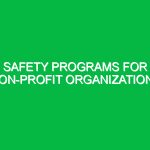Introduction
Safety in recreational facilities is a critical aspect of the Health, Safety, and Environment (HSE) domain. These spaces, which range from parks and sports complexes to swimming pools and playgrounds, serve as essential venues for community engagement, physical activity, and leisure. However, they also present various hazards that can compromise the well-being of users. Understanding and implementing effective safety measures is not just a regulatory requirement but a moral obligation for facility operators, users, and the broader community.
Understanding the Hazards and Risks
Every recreational facility comes with its unique set of hazards, which can lead to accidents if not properly managed. These risks can be broadly categorized into several areas:
Physical Hazards
Physical hazards are perhaps the most visible risks in recreational facilities. From uneven surfaces in a park to improperly maintained equipment in a playground, these hazards can result in slips, trips, and falls. For instance, a personal anecdote from a local sports complex highlights the importance of this. A friend of mine, while playing basketball, slipped on a wet floor near the court entrance, leading to a sprained ankle. This incident underlines the need for regular maintenance and prompt cleaning to mitigate such risks.
Environmental Hazards
Environmental hazards also play a significant role in safety concerns. In facilities with water features, such as swimming pools or lakes, the risk of drowning is a primary concern. Additionally, weather-related issues, such as lightning during outdoor events or extreme heat during summer, can pose significant threats. For example, a thunderstorm that rolled through a local park once resulted in multiple injuries before the event organizers could clear the area. This incident stresses the importance of having clear, enforced protocols for weather-related emergencies.
Biological Hazards
Biological hazards, including bacteria and viruses, are another critical concern, especially in recreational facilities that involve water. Swimming pools can become breeding grounds for harmful pathogens if not well-maintained. An outbreak of a waterborne illness linked to a poorly chlorinated pool at a summer camp several years ago serves as a reminder of the necessity for stringent hygiene practices.
Equipment Hazards
Lastly, equipment hazards are prevalent in recreational facilities. From outdated playground apparatus to malfunctioning gym equipment, these risks can lead to serious injuries. A case study involving a malfunctioning zip line at a community park resulted in multiple injuries when the safety harnesses failed. This incident underscores the importance of routine inspections and maintenance of recreational equipment.
Implementing Safety Precautions and Best Practices
With a clear understanding of the potential hazards, the focus shifts to implementing effective safety precautions. Here are several best practices that can significantly enhance safety in recreational facilities:
Regular Maintenance and Inspections
Establishing a routine schedule for maintenance and inspections is vital. This includes checking all equipment, playgrounds, and sports facilities for wear and tear. Facilities should document these inspections and address any issues immediately. For instance, a community center I visited had a weekly inspection checklist prominently displayed, ensuring staff were diligent in their upkeep efforts.
Staff Training and Emergency Preparedness
Training staff to recognize hazards and respond to emergencies can greatly reduce risks. Regular training sessions can cover first aid, CPR, and emergency evacuation procedures. In one memorable instance, a lifeguard at a local pool successfully executed CPR on a child who had nearly drowned, thanks to her extensive training. This highlights the life-saving importance of preparedness.
Clear Signage and Communication
Effective signage can guide users on safe practices and warn them of potential hazards. For example, pool facilities should have clear rules about diving and swimming alone. Additionally, facilities can benefit from regular announcements about safety protocols, especially during events. In another example, a local amusement park implemented a system of alerts for ride safety that reduced accidents significantly.
Emergency Response Plans
Each facility should have a detailed emergency response plan that outlines procedures for various scenarios, including medical emergencies, severe weather, and fire evacuations. Regular drills can ensure that staff and users are familiar with these procedures. When a fire alarm went off during a summer camp at a local recreation center, the swift action of the staff, who executed the emergency plan flawlessly, ensured everyone was safely evacuated.
Community Engagement and Awareness Programs
Engaging the community can enhance safety awareness. Programs that educate users about facility rules, safety practices, and emergency procedures can foster a culture of safety. For instance, a local park held a safety day, where families participated in workshops on safe play practices, which not only educated but also built community ties.
Regulations and Standards Governing Recreational Facilities
In the realm of safety in recreational facilities, various regulations and standards come into play. These guidelines help ensure that safety practices are not left to chance but are systematically enforced. Here are a few key regulations:
Occupational Safety and Health Administration (OSHA) Standards
OSHA sets forth guidelines to ensure safe and healthy working conditions. Although primarily focused on employees, these standards also impact the safety of recreational facilities by establishing protocols for equipment maintenance, training, and emergency response.
American National Standards Institute (ANSI) Standards
ANSI provides a framework for safety standards in recreational facilities, particularly concerning playground equipment and safety surfacing. Facilities are encouraged to comply with these standards to minimize risk and enhance user safety.
Local and State Regulations
Local and state authorities often have specific regulations governing recreational facilities, including health codes for swimming pools and safety regulations for public parks. It’s crucial for facility managers to stay informed about these regulations to ensure compliance and avoid penalties.
Conclusion
Safety in recreational facilities is not just a regulatory requirement; it is essential for fostering healthy, thriving communities. By understanding the potential hazards and implementing effective safety practices, facility operators can significantly reduce risks and create a safe environment for all users. Whether through routine maintenance, staff training, or community engagement, a concerted effort towards safety can make recreational facilities a safe haven for enjoyment and relaxation. Ultimately, a proactive approach to safety ensures that these spaces fulfill their purpose of enriching lives without compromising health and well-being.


